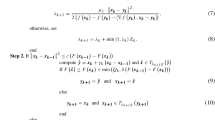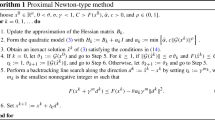Abstract
Extended linear-quadratic programming arises as a flexible modeling scheme in dynamic and stochastic optimization, which allows for penalty terms and facilitates the use of duality. Computationally it raises new challenges as well as new possibilities in large-scale applications. Recent efforts have been focused on the fully quadratic case ([15] and [23]), while relying on the fundamental proximal point algorithm (PPA) as a shell of “outer” iterations when the problem is not fully quadratic. In this paper, we focus on the nonfully quadratic cases by proposing some new variants of the fundamental PPA. We first construct a continuously differentiable saddle function S(u, v) through infimal convolution in such a way that the optimal primal-dual pairs of the original problem are just the saddle points of S(u, v) on the whole space. Then the original extended linear-quadratic-programming problem reduces to solving the nonlinear equation ∇S(u, v)=0. We then embed the fundamental PPA and some of its previous variants in the framework of a Newton-like iteration for this equation. After revealing the local quadratic structure of S near the solution, we derive new extensions of the fundamental PPA. In numerical tests, the modified iteration scheme based on the quasi-Newton update formula outperforms the fundamental PPA considerably.
Similar content being viewed by others
References
J.V. Burke and M.C. Ferris, “Characterization of solution sets of convex programs,” Oper. Res. Letters, vol. 10, pp. 57–60, 1991.
J.E. Dennis Jr. and Jorge J. Moré, “Quasi-Newton methods, motivation and theory,” SIAM Rev., vol. 19, pp. 47–89, 1977.
J.E. Dennis Jr. and R.B. Schnabel, “Least change secant updates for Quasi-Newton methods,” SIAM Rev., vol. 21, pp. 443–459, 1979.
D. Gabay, “Application of the Method of Multipliers to Variational Inequalities,” in Augmented Lagrangian Methods: Applications to the Numerical Solutions of Boundary-Value Problems (M. Fortin and R. Golwinski, eds.), North-Holland, Amsterdam, 1983.
A. King, “An implementation of the Lagrangian finite generation method,” in Numerical Techniques for Stochastic Programming Problems (Y. Ermoliev and R.J.-B. Wets, eds.), Springer-Verlag, 1988.
F.J. Luque, “Asymptotic convergence analysis of the proximal point algorithm” SIAM J. Control Opt., vol. 22, pp. 277–293, 1984.
G.J. Minty, “Monotone (nonlinear) operators in Hilbert space,” Duke Math. J., vol. 29, pp. 341–346, 1962.
J.J. Moreau, “Proximité et dualité dans un espace Hilbertien,” Bull. Soc. Math. Fr., vol. 93, pp. 273–299, 1965.
S.M. Robinson, “Some continuity properties of polyhedral multifunctions,” Math. Programming Studies, vol. 14, pp. 206–214, 1981.
R.T. Rockafellar, Convex Analysis, Princeton Univ. Press, Princeton, NJ, 1970.
R.T. Rockafellar, “Monotone operators associated with saddle functions and minimax problems,” in Nonlinear Functional analysis, Part 1, (F.E. Browder, ed.), Symposia in Pure Math., vol. 18, Amer. Math Soc., Providence, R.I., 1970, pp. 241–250.
R.T. Rockafellar, “Monotone operators and the proximal point algorithm,” SIAM J. Control Opt., vol. 14, pp. 877–898, 1976.
R.T. Rockafellar, “A generalized approach to linear-quadratic programming,” in Proc. Int. Conf. on Numerical Optimization and Appl., Xi'an, China, pp. 58–66, 1986.
R.T. Rockafellar, “Linear-quadratic programming and optimal control,” SIAM J. Control Opt., vol. 25, pp. 781–814, 1987.
R.T. Rockafellar, “Computational schemes for solving large-scale problems in extended linear-quadratic programming,” Math. Programming, vol. 48, pp. 447–474, 1990.
R.T. Rockafellar, “Large-scale extended linear-quadratic programming and multistage optimization,” in Proc. Fifth Mexico-U.S. Workshop on Numerical Analysis (S. Gomez, J.-P. Hennart, R. Tapia, eds.), SIAM Publications, 1990.
R.T. Rockafellar and R.J.-B. Wets, “A Lagrangian finite generation technique for solving linear-quadratic problems in stochastic programming,” Math. Programming Studies, vol. 28, pp. 63–93, 1986.
R.T. Rockafellar and R.J.-B. Wets, “Linear-quadratic problems with stochastic penalities: The finite generation algorithm,” in Numerical Techniques for Stochastic Optimization Problems (Y. Ermoliev and R. J.-B. Wets, eds.), Springer-Verlag Lecture Notes in Control and Information Sciences No. 81, pp. 545–560, 1987.
R.T. Rockafellar and R. J.-B. Wets, “Generalized linear-quadratic problems of deterministic and stochastic optimal control in discrete time,” SIAM J. Control Opt., vol. 28, pp. 810–822, 1990.
J.M. Wagner, Stochastic Programming with Recourse Applied to Groundwater Quality Management, PhD dissertation, M.I.T., Cambridge, MA, 1988.
S.E. Wright (with introduction by R.T. Rockafellar), “DYNFGM: Dynamic Finite Generation Method,” Department of Mathematics, University of Washington, 1989.
C. Zhu, Methods for Large-Scale Extended Linear-Quadratic Programming, PhD dissertation, University of Washington, 1991.
C. Zhu and R.T. Rockafellar, “Primal-dual projected gradient algorithms for extended linear-quadratic programming,” Submitted to SIAM J. Opt., 1990.
Author information
Authors and Affiliations
Rights and permissions
About this article
Cite this article
Zhu, C. Modified proximal point algorithm for extended linear-quadratic programming. Comput Optim Applic 1, 185–205 (1992). https://doi.org/10.1007/BF00253806
Received:
Revised:
Issue Date:
DOI: https://doi.org/10.1007/BF00253806




